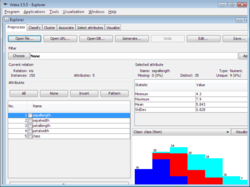Weka (software)
 Weka 3.5.5 with Explorer window open with Iris UCI dataset | |
| Developer(s) | University of Waikato |
|---|---|
| Stable release | 3.4.17 (book), 3.6.3 (stable), 3.7.2 (development)
/ 2010/07/30 |
| Repository | |
| Operating system | Cross-platform |
| Type | Machine Learning |
| License | GNU General Public License |
| Website | http://www.cs.waikato.ac.nz/~ml/weka/ |
Weka (Waikato Environment for Knowledge Analysis) is a popular suite of machine learning software written in Java, developed at the University of Waikato, New Zealand. WEKA is free software available under the GNU General Public License.
Description

The Weka workbench[1] contains a collection of visualization tools and algorithms for data analysis and predictive modeling, together with graphical user interfaces for easy access to this functionality. The original non-Java version of Weka was a TCL/TK front-end to (mostly third-party) modeling algorithms implemented in other programming languages, plus data preprocessing utilities in C, and a Makefile-based system for running machine learning experiments. This original version was primarily designed as a tool for analyzing data from agricultural domains,[2][3] but the more recent fully Java-based version (Weka 3), for which development started in 1997, is now used in many different application areas, in particular for educational purposes and research. The main strengths of Weka are that it:
- is freely available under the GNU General Public License,
- is very portable because it is fully implemented in the Java programming language and thus runs on almost any modern computing platform,
- contains a comprehensive collection of data preprocessing and modeling techniques, and
- is easy to use by a novice due to the graphical user interfaces it contains.
Weka supports several standard data mining tasks, more specifically, data preprocessing, clustering, classification, regression, visualization, and feature selection. All of Weka's techniques are predicated on the assumption that the data is available as a single flat file or relation, where each data point is described by a fixed number of attributes (normally, numeric or nominal attributes, but some other attribute types are also supported). Weka provides access to SQL databases using Java Database Connectivity and can process the result returned by a database query. It is not capable of multi-relational data mining, but there is separate software for converting a collection of linked database tables into a single table that is suitable for processing using Weka[4]. Another important area that is currently not covered by the algorithms included in the Weka distribution is sequence modeling.
Weka's main user interface is the Explorer, but essentially the same functionality can be accessed through the component-based Knowledge Flow interface and from the command line. There is also the Experimenter, which allows the systematic comparison of the predictive performance of Weka's machine learning algorithms on a collection of datasets.
The Explorer interface has several panels that give access to the main components of the workbench. The Preprocess panel has facilities for importing data from a database, a CSV file, etc., and for preprocessing this data using a so-called filtering algorithm. These filters can be used to transform the data (e.g., turning numeric attributes into discrete ones) and make it possible to delete instances and attributes according to specific criteria. The Classify panel enables the user to apply classification and regression algorithms (indiscriminately called classifiers in Weka) to the resulting dataset, to estimate the accuracy of the resulting predictive model, and to visualize erroneous predictions, ROC curves, etc., or the model itself (if the model is amenable to visualization like, e.g., a decision tree). The Associate panel provides access to association rule learners that attempt to identify all important interrelationships between attributes in the data. The Cluster panel gives access to the clustering techniques in Weka, e.g., the simple k-means algorithm. There is also an implementation of the expectation maximization algorithm for learning a mixture of normal distributions. The next panel, Select attributes provides algorithms for identifying the most predictive attributes in a dataset. The last panel, Visualize, shows a scatter plot matrix, where individual scatter plots can be selected and enlarged, and analyzed further using various selection operators.
History
- In 1993, the University of Waikato in New Zealand started development of the original version of Weka (which became a mixture of TCL/TK, C, and Makefiles).
- In 1997, the decision was made to redevelop Weka from scratch in Java, including implementations of modeling algorithms.[5]
- In 2005, Weka receives the SIGKDD Data Mining and Knowledge Discovery Service Award[6][7]
- In 2006, Pentaho Corporation acquired an exclusive licence to use Weka for business intelligence. It forms the data mining and predictive analytics component of the Pentaho business intelligence suite.
- All-time ranking on Sourceforge.net as of 2009-06-11, 246 (with 1,566,318 downloads)
See also
- Data mining
- RapidMiner (formerly YALE (Yet Another Learning Environment)) open-source machine learning framework implemented in Java fully integrating Weka
- ELKI is a similar project to Weka with a focus on clustering algorithms (i.e. unsupervised methods, data mining as opposed to machine learning)
- KNIME
- List of numerical analysis software
References
- ^ Ian H. Witten (2005). "Data Mining: Practical machine learning tools and techniques, 2nd Edition". Morgan Kaufmann, San Francisco. Retrieved 2007-06-25.
{{cite web}}: Unknown parameter|coauthors=ignored (|author=suggested) (help) - ^ G. Holmes (1994). "Weka: A machine learning workbench" (PDF). Proc Second Australia and New Zealand Conference on Intelligent Information Systems, Brisbane, Australia. Retrieved 2007-06-25.
{{cite web}}: Unknown parameter|coauthors=ignored (|author=suggested) (help) - ^ S.R. Garner (1995). "Applying a machine learning workbench: Experience with agricultural databases" (PDF). Proc Machine Learning in Practice Workshop, Machine Learning Conference, Tahoe City, CA, USA. pp. 14–21. Retrieved 2007-06-25.
{{cite web}}: Unknown parameter|coauthors=ignored (|author=suggested) (help) - ^ P. Reutemann (2004). "Proper: A Toolbox for Learning from Relational Data with Propositional and Multi-Instance Learners". 17th Australian Joint Conference on Artificial Intelligence (AI2004). Springer-Verlag. Retrieved 2007-06-25.
{{cite web}}: Unknown parameter|coauthors=ignored (|author=suggested) (help) - ^ Ian H. Witten (1999). "Weka: Practical Machine Learning Tools and Techniques with Java Implementations" (PDF). Proceedings of the ICONIP/ANZIIS/ANNES'99 Workshop on Emerging Knowledge Engineering and Connectionist-Based Information Systems. pp. 192–196. Retrieved 2007-06-26.
{{cite web}}: Unknown parameter|coauthors=ignored (|author=suggested) (help) - ^ Gregory Piatetsky-Shapiro (2005-06-28). "KDnuggets news on SIGKDD Service Award 2005". Retrieved 2007-06-25.
- ^ "Overview of SIGKDD Service Award winners". 2005. Retrieved 2007-06-25.
External links
- General
- Weka Project home page at University of Waikato in New Zealand
- Weka Project home page at SourceForge.net (acquired by Pentaho in September 2006)
- Wiki with FAQs, HOWTOs, code-snippets, etc.
- Examples of applications
- Acronym identification
- Gene selection from microarray data for cancer classification
- QSPR of metal complexation
- Classification of Expressed sequence tag (EST) data from plant/pathogen interface
- Further related projects and applications
- Extended versions
